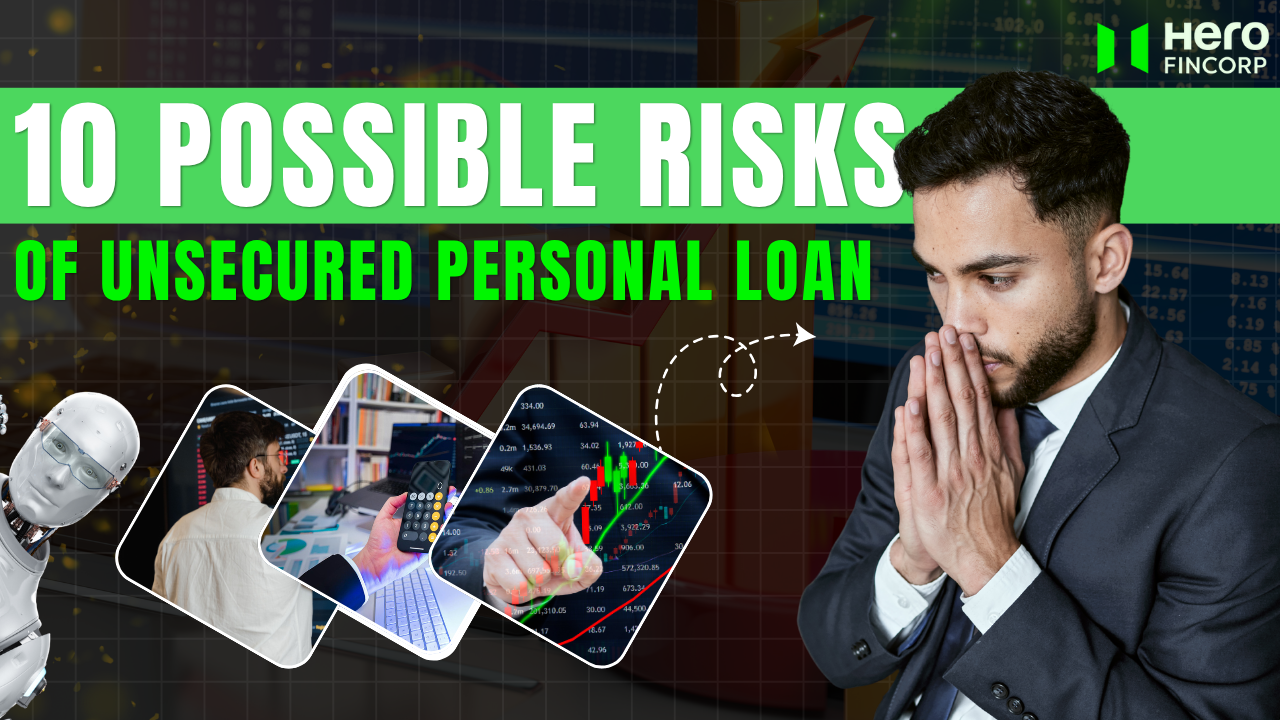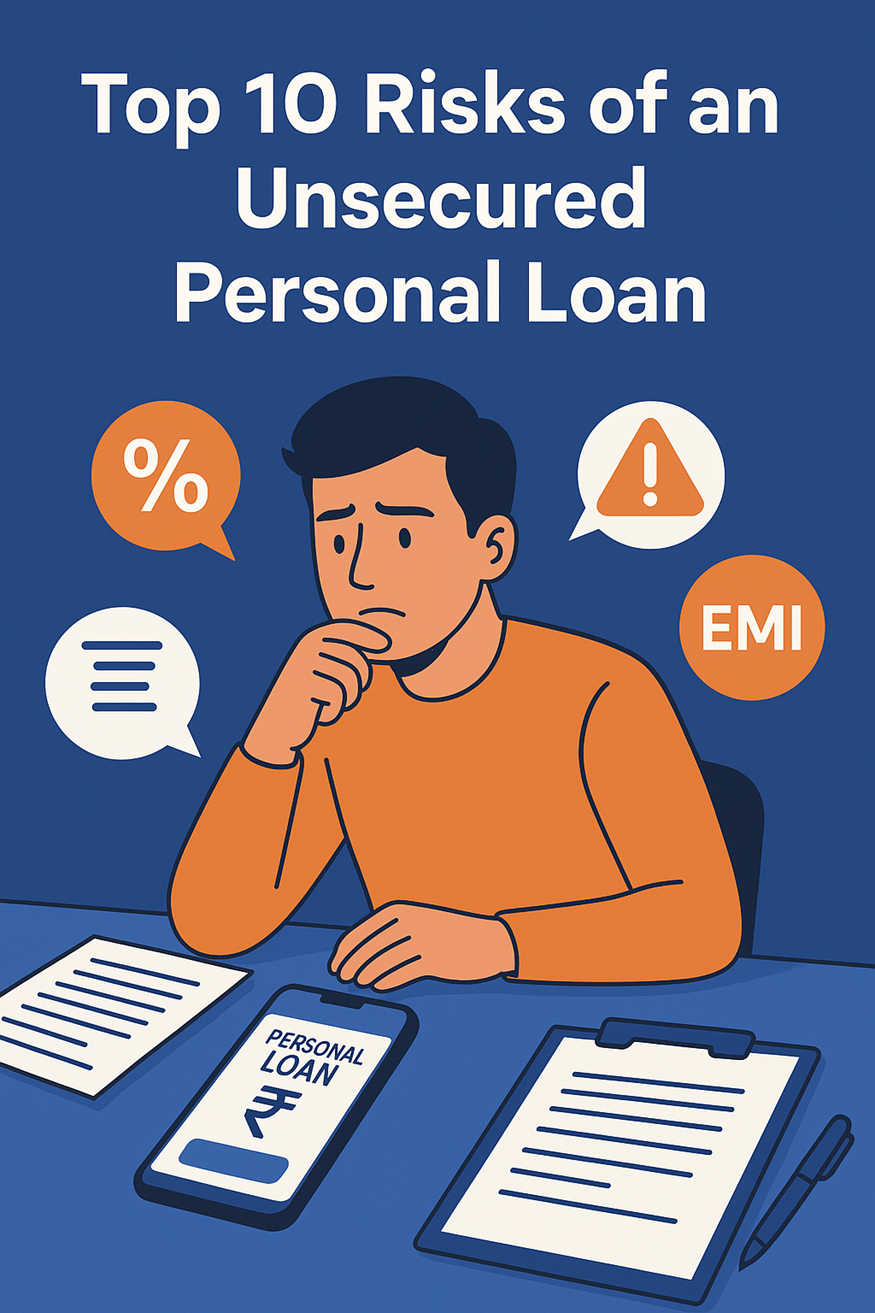10 Possible Risks of an Unsecured Personal Loan

Did you know that 67% of Indians have taken a personal loan to meet their funding requirements? A primary reason behind this is that they are quick and easy to apply and have no end-usage restriction, giving you the freedom to utilise the fund for anything.
So, are you, too, thinking of getting an unsecured personal loan? It's better to assess the associated risks to avoid financial burden.
So before you hit "apply", these are some of the risks of unsecured loans you should be aware of, and why you should steer clear of them at all costs.
What is an Unsecured Personal Loan?
Unlike a secured loan, an unsecured personal loan is a credit option in which the lenders do not ask the borrower to pledge any asset as security or collateral.
You can apply for a personal loan to cover a wide range of expenses, including medical emergencies, weddings, travel, home repairs, and other significant events. But because there’s no collateral, the interest rates are higher compared to secured credit options, and they add a few extra checks before they approve.
In short, you’re borrowing money without pledging anything, which is great for convenience, but it comes at a price.
Top 10 Risks of an Unsecured Personal Loan
Unsecured loans can offer instant relief in emergencies, but they also carry hidden costs and conditions that borrowers often overlook. Here are ten risks every applicant should understand before applying.

1. High and Variable Interest Rates
The most common risk of an unsecured personal loan is the high cost of borrowing. As the lender does not have security, the loan is financed based on your credit report and your income stability. The borrowers with a poor credit score normally end up paying higher interest rates.
Secondly, certain lenders charge variable rates, which increase your equated monthly instalments (EMIs) in response to changes in the market or the benchmark lending rate. This renders the amount of total repayment uncertain and generally higher than expected.
2. Hidden Fees and Upfront Charges
It’s not just the interest you’re paying. There’s often a “processing fee,” “documentation charge,” or something else tucked quietly into the agreement.
That’s why smart borrowers don’t just ask for the interest rate; they ask for the APR (Annual Percentage Rate). It includes everything you’ll actually pay, so that you know exactly what you need to pay on a monthly basis.
3. Penalties for Early Repayment
It sounds odd, but yes, paying off your loan early can sometimes cost you. Lenders often charge a foreclosure or prepayment penalty (like 4%) because they lose the interest they would’ve earned.
So if you are planning to repay your loan amount earlier than the chosen term, check the fine print first. It’s better to know what you’ll actually save before rushing to pay it off.
4. Impact on Credit Score
When you apply for a loan, it triggers a hard inquiry on your credit report, which can lower your score slightly. Additionally, late EMI payments or defaults hurt much more, as they can lower your score by 50-60 points. This can impact your ability to obtain loans or credit cards in the future.
5. Risk Weight of Unsecured Loans for Lenders
Here’s something most borrowers don’t think about. Even for lenders, unsecured loans are “riskier assets.”
Under RBI rules, banks must hold more capital against them. The higher the risk weight, the higher the internal cost. And guess who ends up paying for it? You, the borrower, pay higher interest rates.
That’s why unsecured credit almost always costs more than secured loans like car or home loans.
6. Lack of Collateral Increases Borrowing Costs
With no asset backing your loan, the lender’s only real assurance is your repayment discipline. If you default, they can’t sell anything to recover the money. Their only option is to pursue repayment through legal means.
So, to offset that risk, most lenders raise the rate or tighten the eligibility rules. In short, you’re paying extra for not pledging collateral.
7. Potential for Over-Indebtedness
The problem with easy loans? They make spending easier, too.
When approvals are instant and limits look generous, it’s tempting to borrow for things that aren’t urgent, like a holiday, a new gadget, or another EMIs-worth purchase. But debt stacks up faster than most people expect. Soon, multiple EMIs start eating into your income, and managing cash flow becomes stressful.
8. Limited Borrower Protection and Privacy Concerns
Digital lending has opened doors, but not all lenders play fair. Some unregulated apps misuse borrower data or use aggressive recovery tactics. It’s become such a problem that the RBI had to step in with new digital lending guidelines.
If you’re borrowing online, always choose an RBI-registered NBFC or bank. Trusted names like Hero FinCorp follow proper data protection norms and fair collection practices, exactly what you want when sharing sensitive financial details.
9. Influence of Mis-selling and Add-on Insurance Products
Many borrowers are offered loan insurance or top-up schemes that they don’t fully understand. These add-ons increase your total cost and may not always be necessary.
10. Complicated Terms and Lack of Transparency
Loan agreements often involve extensive paperwork and complex terms. This lack of transparency may lead to borrowers not understanding repayment options, default penalties, or other charges fully.
This risk is amplified in contracts where interest is precomputed (fixed for the term) rather than calculated daily on the reducing balance, which costs the borrower more over time.
How to Mitigate the Risks of Unsecured Personal Loans?
No loan is entirely risk-free. However, if you follow a few financial tips, you can definitely stay away from borrower’s risks.
● Borrow less than you qualify for - Just because you’re eligible for ₹5 lakh doesn’t mean you need it. Keep your EMI within a range you can handle even if your income dips.
● Compare at least two or three lenders - Don’t just go with the first lender you come across. Look at the APR, tenure flexibility, and reputation.
● Understand your repayment window - A shorter tenure means higher EMIs but lower total interest. A longer one eases monthly stress but costs more overall. Ideally, your EMI shouldn't exceed 40%-50% of your monthly budget to minimise chances of default.
● Keep a safety buffer - Always maintain at least 3-6 months of emergency funds in your account. This reduces the likelihood of missed payments due to insufficient funds.
● Read, don’t skim - Go through the offer document line by line, especially around processing fees, insurance clauses, and penalties.
The easiest way to manage all this? Borrow through a trusted NBFC like Hero FinCorp, where terms are transparent and you know exactly what you’re signing up for.
Why Choose a Trusted NBFC like Hero FinCorp for Your Personal Loan Needs?

In the case of unsecured personal loans, trust is more important than speed or rates. Most online lenders give instant approval but tend to neglect what really makes for a good borrowing experience: transparency, accountability, and assistance.
That's where Hero FinCorp differentiates itself. Hero FinCorp's personal loan process is designed around transparency; no fine print, inflated fees, or unexpected deductions. You know what you're committing to, from the first screen.
This enables you to obtain a loan with -
● Digital-first process - Apply, confirm, and get approved, all online.
● Minimal paperwork - No burdensome documents or unnecessary proofs.
● Rapid approval and disbursement - Receive funds in your account quickly than most banks.
● Flexible repayment - Tenures of your choice, ranging from 12 to 36 months.
Apply for an Instant Personal Loan and feel the difference of responsible digital lending.
Frequently Asked Questions
1. How Does a Personal Loan Affect My Credit Score in India?
A personal loan can have a temporary impact on your credit score through a hard inquiry. If you miss a payment deadline or face a delay in payment, it can cause a massive fall.
2. What Is the Risk Weight of Unsecured Loans, and Why Does It Matter to Me?
Unsecured loans' risk weight is a high rate (e.g., 100%) by the RBI. It's important because it compels the lender to maintain greater capital, which is one of the main reasons unsecured loans have higher interest rates for the borrower.
3. How Can I Avoid High Fees and Hidden Charges on Personal Loans?
You can avoid them by asking for the Annual Percentage Rate (APR), which includes all fees, and by carefully reading the loan agreement's fine print before signing.
4. Is It Safer to Take a Secured Loan Compared to an Unsecured Loan?
Not exactly. Secured loans, like house or car loans, are cheaper in terms of interest, but risk losing your asset if you do not pay. Unsecured personal loans are more expensive in interest terms, but there is no requirement to provide collateral